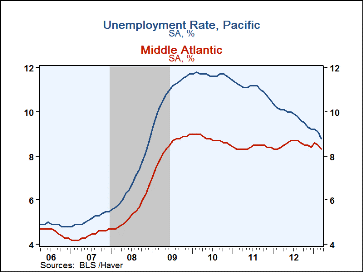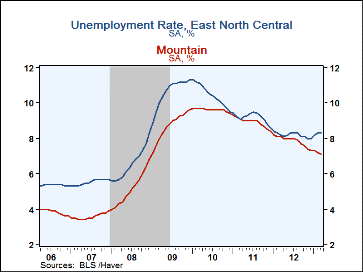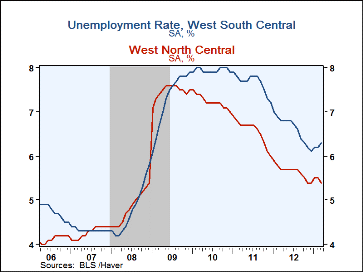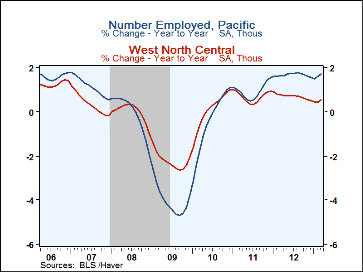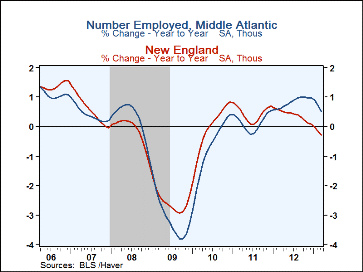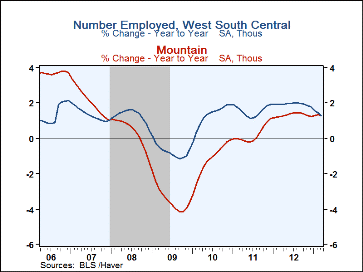 Global| Apr 19 2013
Global| Apr 19 2013State Labor Market Conditions Are All Over The U.S. Map
by:Tom Moeller
|in:Economy in Brief
Summary
Depending on where you live in the U.S., the unemployment rate may vary greatly from the country's 7.6% average. Suffering the greatest degree of unemployment is the Pacific region where jobless rates average 8.8%. California averages [...]
Depending on where you live in the U.S., the unemployment rate may vary greatly from the country's 7.6% average. Suffering the greatest degree of unemployment is the Pacific region where jobless rates average 8.8%. California averages the highest rate at 9.4%. In the Los Angeles-Long Beach-Glendale areas alone, the rate sits at 10.2%. At the other end of the regional range is Hawaii where the jobless rate is just 5.1%.
In the heavily populated Middle Atlantic and East North Central states, unemployment rates averaging 8.3% are also above the rest of the nation. New Jersey's 9.0% rate is at the high end of the range. Also high is Michigan (8.5%), where the rate is down considerably from a 14.2% peak in August of 2009. That's still is elevated, however, by a sluggish industrial sector. Detroit's rate alone is 9.9%, down from 16.0% at the depths of the last recession.
In the West South Central states, the unemployment rate is below the national average at 6.3%. In Texas, the jobless rate stands at 6.4%; Louisiana averages 6.2% while Oklahoma's rate is substantially lower at 5.0%. Regionally, the lowest unemployment rates can be found in the least populated states of the West North Central area. Here, unemployment rates of 3.3% in North Dakota, 4.9% in Iowa and 6.7% in Missouri help bring the region's average to just 5.4%.
| Mar | Feb | Mar'12 | 2012 | 2011 | 2010 | |
|---|---|---|---|---|---|---|
| U.S. Average Unemployment Rate (%) | 7.6 | 7.7 | 8.2 | 8.1 | 8.9 | 9.6 |
| State Unemployment Rates | ||||||
| Pacific | 8.8 | 9.1 | 10.1 | 9.8 | 11.1 | 11.7 |
| Middle Atlantic | 8.3 | 8.5 | 8.4 | 8.5 | 8.4 | 8.8 |
| East North Central | 8.3 | 8.3 | 8.2 | 8.2 | 9.2 | 10.5 |
| East South Central | 8.0 | 7.9 | 8.0 | 8.1 | 9.4 | 9.9 |
| South Atlantic | 7.6 | 7.8 | 8.3 | 8.2 | 9.3 | 9.9 |
| Mountain | 7.1 | 7.2 | 8.1 | 7.9 | 8.9 | 9.6 |
| New England | 6.9 | 7.0 | 7.1 | 7.2 | 7.8 | 8.5 |
| West South Central | 6.3 | 6.2 | 6.8 | 6.6 | 7.7 | 7.9 |
| West North Central | 5.4 | 5.5 | 5.7 | 5.7 | 6.6 | 7.2 |
Pacific; AK, CA, HI, OR, WA -- Middle Atlantic; NJ, NY, PA -- East North Central; IL, IN, MI, OH, WI -- East South Central; AL, KY, MS, TN -- South Atlantic; DE, DC, FL, GA, MD, NC, SC, VA, WV -- Mountain; AZ, CO, ID, MT, NV, NM, UT, WY -- New England; CT, ME, MA, NH, RI, VT -- West South Central; AR, LA, OK, TX -- West North Central; IA, KS, MN, MO, NE, ND, SD
The variation in unemployment rates obviously reflects great differences in job growth. In the Pacific states, job growth has averaged 1.7% y/y. Growth of 2.3% y/y in California, however, contrasts sharply with negative growth of 1.0% y/y in Oregon. In the South Atlantic states, growth has averaged 1.5% y/y. Florida has realized the strongest job increase of 2.3% y/y with South Carolina at 1.2% y/y.
In the heavily populated Middle Atlantic states, employment rose just 0.5% over the last year. New Jersey saw 1.2% y/y job growth but New York realized just a 0.2% y/y gain. Jobs grew an average 0.5% y/y in Pennsylvania. The least populated West North Central States also had just 0.5% job gains with North Dakota at 1.8% y/y, Minnesota at 0.7% y/y and South Dakota a minimal 0.4% y/y.
At the low end of the range for job growth has been New England. Here, jobs have fallen 0.3% over the last year following negative growth rates extending back to 2008. In Connecticut jobs fell 1.6% during the last twelve months and in Massachusetts employment levels were unchanged y/y. Also realizing an average 0.2% y/y decline in jobs was the East North Central states of Illinois and Indiana (-0.4% y/y) Ohio (-0.4% y/y) and Michigan (-0.2% y/y).
Some Unpleasant Implications for Unemployment Targeters is the title of this week's speech by St. Louis Fed President James Bullard and it can be found here.
| Mar | Feb | Mar'12 | 2012 | 2011 | 2010 | |
|---|---|---|---|---|---|---|
| U.S. Average Employment Growth (Y/Y %) | 0.9 | 1.0 | 1.7 | 1.8 | 0.6 | -0.6 |
| State Employment Growth | ||||||
| Pacific | 1.7 | 1.6 | 1.6 | 1.7 | 0.9 | -0.5 |
| South Atlantic | 1.5 | 1.7 | 2.0 | 2.0 | 1.6 | -0.1 |
| West South Central | 1.3 | 1.5 | 1.9 | 1.9 | 1.5 | 1.3 |
| Mountain | 1.3 | 1.3 | 1.2 | 1.3 | 0.2 | -1.3 |
| Middle Atlantic | 0.5 | 0.7 | 0.6 | 0.8 | 0.1 | -0.8 |
| East South Central | 0.5 | 0.6 | 1.0 | 1.1 | 1.5 | 1.5 |
| West North Central | 0.5 | 0.4 | 0.8 | 0.7 | 0.7 | 0.1 |
| East North Central | -0.2 | -0.0 | 0.9 | 0.8 | 0.6 | -0.8 |
| New England | -0.3 | -0.2 | 0.5 | 0.4 | 0.4 | -0.1 |
Tom Moeller
AuthorMore in Author Profile »Prior to joining Haver Analytics in 2000, Mr. Moeller worked as the Economist at Chancellor Capital Management from 1985 to 1999. There, he developed comprehensive economic forecasts and interpreted economic data for equity and fixed income portfolio managers. Also at Chancellor, Mr. Moeller worked as an equity analyst and was responsible for researching and rating companies in the economically sensitive automobile and housing industries for investment in Chancellor’s equity portfolio. Prior to joining Chancellor, Mr. Moeller was an Economist at Citibank from 1979 to 1984. He also analyzed pricing behavior in the metals industry for the Council on Wage and Price Stability in Washington, D.C. In 1999, Mr. Moeller received the award for most accurate forecast from the Forecasters' Club of New York. From 1990 to 1992 he was President of the New York Association for Business Economists. Mr. Moeller earned an M.B.A. in Finance from Fordham University, where he graduated in 1987. He holds a Bachelor of Arts in Economics from George Washington University.


